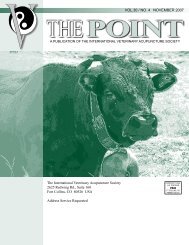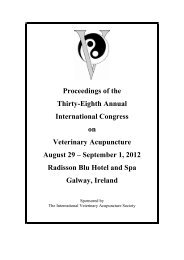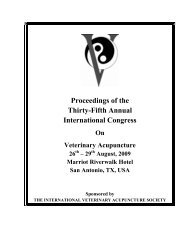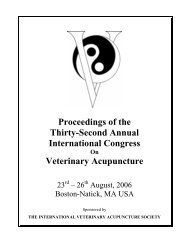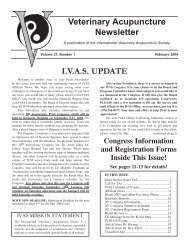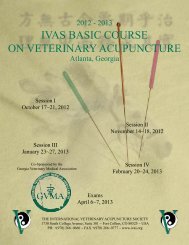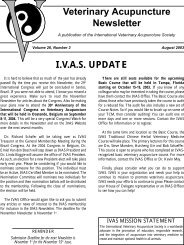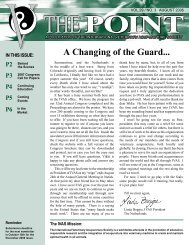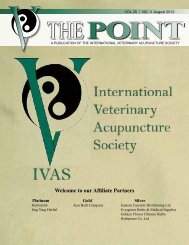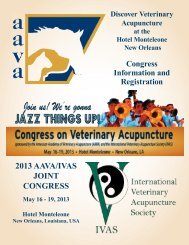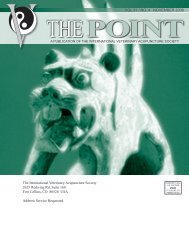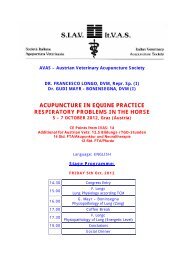I.V.A.S. UPDATE Veterinary Acupuncture Newsletter - International ...
I.V.A.S. UPDATE Veterinary Acupuncture Newsletter - International ...
I.V.A.S. UPDATE Veterinary Acupuncture Newsletter - International ...
You also want an ePaper? Increase the reach of your titles
YUMPU automatically turns print PDFs into web optimized ePapers that Google loves.
<strong>Veterinary</strong> <strong>Acupuncture</strong><br />
<strong>Newsletter</strong><br />
A publication of the <strong>International</strong> <strong>Veterinary</strong> <strong>Acupuncture</strong> Society<br />
Volume 26, Number 2 May 2003<br />
Welcome to the May issue of the IVAS <strong>Newsletter</strong>! Spring has<br />
finally come to Colorado; hopefully you are also having nice weather.<br />
Much continues to happen with your organization and this issue of the<br />
<strong>Newsletter</strong> contains quite a bit of information.<br />
Inside you will again find information on the upcoming 29 th Congress,<br />
which will be held in Santos, Brazil, August 20-23, 2004. Please make<br />
your plans to attend this first Congress held in South America!<br />
As was reported in the February <strong>Newsletter</strong>, the Program Committee<br />
has worked very hard to develop a well-rounded program that will<br />
appeal to small animal, as well as large animal/equine colleagues. This<br />
<strong>Newsletter</strong> contains a tentative schedule for the Congress along with<br />
speaker names and lecture topics. Please note that the IVAS Board and<br />
House of Delegates will hold meetings on Wednesday morning, August<br />
20 th ; exact times will be sent to the members. More information is also<br />
included concerning the equine wetlabs to be offered by Dr. Jean-<br />
Yves Guray and Dr. Marcio Bernstein. This should be another fantastic<br />
Congress - send in your registration now!<br />
The IVAS Board of Directors has just concluded a meeting and some<br />
of their decisions are noted in this <strong>Newsletter</strong>. The IVAS House of<br />
Delegates is holding a meeting as we go to press for this <strong>Newsletter</strong>.<br />
Please remember that the HOD is your voice in IVAS. If you have<br />
questions or concerns, please contact your HOD representative.<br />
In other IVAS Office business, Rachael Willson, our bookkeeper,<br />
submitted her resignation due to family matters. Rachael will be moving<br />
back to her home state of Texas. We are sorry to see Rachael leave us<br />
and we wish her well in her future endeavors. Our new bookkeeper is<br />
Catherine Mullet. We are very pleased to have Catherine with us and<br />
hope you will welcome her to the IVAS family. If you have any questions<br />
about your dues, registrations or orders, give Catherine a call.<br />
IVAS Board Confirms Dr. Rick Schafer<br />
as New IVAS Treasurer<br />
During the just concluded IVAS Board Meeting, the Board of<br />
Directors confirmed Dr. Rick Schafer of Corpus Christi, Texas, as<br />
REMINDER<br />
Submission Deadline for the next <strong>Newsletter</strong> is<br />
August 1st for the August 15th issue.<br />
I.V.A.S. <strong>UPDATE</strong><br />
the incoming IVAS Treasurer to succeed Dr. Bob Schaeffer. The<br />
IVAS membership did not submit any other names for nomination;<br />
as such an election was not necessary. The Board unanimously<br />
approved Rick and his term will begin at the General Membership<br />
Meeting at the upcoming Congress. We welcome Rick to the IVAS<br />
Board!<br />
Position Statement on the Practice of <strong>Veterinary</strong><br />
<strong>Acupuncture</strong> by Non-veterinarians<br />
A significant discussion took place during the Board Meeting on the<br />
matter of non-veterinarians practicing acupuncture on animals and on<br />
the teaching of veterinary acupuncture to non-veterinarians. IVAS is<br />
often asked by other organizations and jurisdictions what its position is<br />
on this matter. As such, the IVAS Board of Directors approved the<br />
following position statement:<br />
Practice of <strong>Veterinary</strong> <strong>Acupuncture</strong> by<br />
Non-veterinarians and the Teaching of <strong>Veterinary</strong><br />
<strong>Acupuncture</strong> to Non-Veterinarians<br />
The <strong>International</strong> <strong>Veterinary</strong> <strong>Acupuncture</strong> Society adopted the<br />
following Mission Statement in 1999:<br />
The <strong>International</strong> <strong>Veterinary</strong> <strong>Acupuncture</strong> Society is a worldwide<br />
advocate in the promotion of education, responsible research, and<br />
the integration of acupuncture into veterinary medicine to create and<br />
maintain optimal health in all animals.<br />
With this Mission Statement in mind, the <strong>International</strong> <strong>Veterinary</strong><br />
<strong>Acupuncture</strong> Society holds that the practice of acupuncture in the<br />
treatment of animals should be limited to a veterinarian. We uphold the<br />
principal that only trained veterinarians have the education to fully<br />
diagnose and determine what form of therapy is in the best interest of<br />
the animal, and in the case of zoonotic disease, the human population as<br />
well. Furthermore, that the teaching of veterinary acupuncture should<br />
be limited to graduate veterinarians for the above reasons.<br />
Approved by the IVAS Board of Directors, May 11, 2003.<br />
IVAS MISSION STATEMENT<br />
The <strong>International</strong> <strong>Veterinary</strong> <strong>Acupuncture</strong> Society is a worldwide<br />
advocate in the promotion of education, responsible research,<br />
and the integration of acupuncture into veterinary medicine to<br />
create and maintain optimal health in all animals.
Volume 26, Number 2 <strong>Veterinary</strong> <strong>Acupuncture</strong> <strong>Newsletter</strong><br />
The <strong>International</strong> <strong>Veterinary</strong><br />
<strong>Acupuncture</strong> Society<br />
Board of Directors<br />
*President<br />
Emiel Van den Bosch, D.V.M., Belgium Fax:+32-16-56-1374<br />
Email: EmielVdBosch@skynet.be<br />
*President-elect<br />
Linda Boggie, D.V.M., U.S.A.<br />
Email: lindaboggie@earthlink.net<br />
*Treasurer<br />
Robert Schaeffer, Jr., D.V.M., U.S.A. Fax:+314-353-1245<br />
Email: CallDrBob@aol.com<br />
*Past President<br />
W. Dwight Hooton, D.V.M., U.A.E. Fax:+971-433-59575<br />
*Chair House of Delegate<br />
Sikke Minnema, D.V.M., Netherlands Fax +31-548-363-243<br />
Email: s.minnema@hetnet.nl<br />
*Executive Director<br />
Ed Boldt Jr., D.V.M., U.S.A Fax:+970-266-0777<br />
Email: ivasoffice@aol.com<br />
Boudewijn Claeys D.V.M., Canada –<br />
Chair Int’l Education Committee<br />
Email: bclaeys@attcanada.net<br />
Kristine Elbaek, D.V.M., Denmark<br />
Email: kristine@holi-vet.dk<br />
Peter Grob, Tierarzt, Switzerland<br />
Email: grob.p@bluewin.ch<br />
Kevin May, D.V.M., U.S.A<br />
Email: kjmaymsi@cox.net<br />
Ted Purcell, D.V.M., Canada<br />
Email: glenpark@compusmart.ab.ca<br />
Jean-Yves Guray, D.V.M., Germany<br />
Email: jyguray@online.de<br />
(*)= member of Executive Committee<br />
Published by the <strong>International</strong> <strong>Veterinary</strong> <strong>Acupuncture</strong> Society.<br />
Reproduction in whole or in part without permission of I.V.A.S. is<br />
prohibited. © All rights reserved.<br />
The <strong>International</strong> <strong>Veterinary</strong> <strong>Acupuncture</strong> Society<br />
P.O. Box 271395 • Ft. Collins, CO 80527-1395 U.S.A.<br />
+970-266-0666 • +970-266-0777 (fax)<br />
Email: ivasoffice@aol.com • Website: www.ivas.org<br />
IN THIS ISSUE<br />
Letter from the IVAS Treasurer ............................2<br />
Call for TAs ..............................................................3<br />
News from Roman Skarda .....................................7<br />
29 th Congress Information .....................................8<br />
Tentative 29 th Congress Schedule ..................... 10<br />
Letter from the Exam Committee ..................... 11<br />
Trigger Point Letter from Finland ..................... 12<br />
IVAS CE Listings.................................................. 12<br />
IVAS Calendar of Events ................................... 13<br />
Classified Ads ........................................................ 14<br />
LETTER FROM IVAS<br />
TREASURER<br />
As a result of a lot of hard work the last few years, we<br />
have managed to make a lot of improvements in the way<br />
IVAS functions. The one thing we have not accomplished is<br />
to get IVAS on a consistently sound financial footing. When<br />
I started as Treasurer six years ago, we did not have enough<br />
information about past operations to be able to plan very<br />
well. As we developed that information, we were able to<br />
figure out ways to contain cost, which produced a couple<br />
of profitable years for us. However, when the American<br />
Association of <strong>Veterinary</strong> <strong>Acupuncture</strong> truly developed, our<br />
dues income was dramatically reduced because half of the<br />
money now goes to the new organization. At about the same<br />
time, registration in the U.S. Basic <strong>Acupuncture</strong> Course declined<br />
which had a major impact on our income since the<br />
U.S. Course is a major source of income for the organization.<br />
As a result, for the first time in several years, we will<br />
have an operating deficit this year. This required us to make<br />
a major withdrawal from our reserves, depleting them by<br />
half. Obviously, we cannot continue to operate this way and<br />
remain a viable organization.<br />
Despite inflation and an increase in services provided<br />
by the office, IVAS has not had a dues increase in over eight<br />
years. In order to improve our financial status, the Board of<br />
Directors has approved a dues increase, which will take effect<br />
for the 2004-2005 fiscal year (starting July 1, 2004). The<br />
dues will increase to 128.00 USD for those who pay directly,<br />
and 64.00 USD for those who pay through their affiliate<br />
organizations. Although this seems like a large increase,<br />
it is not enough to make up our deficits. This will be balanced<br />
by further efforts to cut costs.<br />
Whenever there is a discussion of dues we have people<br />
who want to know what they are getting for their money.<br />
We always answer with things like <strong>Newsletter</strong>s and Journals.<br />
In the years I’ve been associated with this organization, I’ve<br />
noticed that this question never comes from the people who<br />
are active in the organization. We are an organization of<br />
1400 members, yet I always see the same 200 or so people<br />
at our functions. If you are one of those people who wants<br />
to know what you are getting for your money, you might<br />
want to ask a different question. “What am I contributing to<br />
IVAS?” You can start right now by planning to attend the
Volume 26, Number 2 <strong>Veterinary</strong> <strong>Acupuncture</strong> <strong>Newsletter</strong><br />
Congress in Santos Brazil. The people responsible have spent<br />
a lot of time and energy to put together an outstanding<br />
meeting.<br />
At its last meeting, the Board of Directors approved<br />
Rick Schafer as your new Treasurer. This was done because<br />
he was the only one nominated. Rick has been acting as Assistant<br />
Treasurer throughout most of my six years as Treasurer.<br />
I would like to thank Rick for his invaluable help and<br />
assure the membership that he is prepared to do a terrific<br />
job as Treasurer when he takes office at the Congress.<br />
Robert G. Schaeffer, Jr. D.V.M.<br />
Treasurer<br />
**************************<br />
Call For<br />
TEACHING ASSOCIATES FOR THE UNITED<br />
STATES BASIC ACUPUNCTURE COURSE<br />
We need Equine/Large Animal Folks!<br />
Come to beautiful, Sunny Tampa in 2003-2004 for 4 sessions<br />
of the US Basic <strong>Acupuncture</strong> Course as a Teaching Associate<br />
and enjoy the challenges and benefits of assisting with the<br />
canine and equine labs and helping other veterinarians learn<br />
acupuncture!<br />
You get all these extras too:<br />
• A new course notebook!<br />
• Lots of IVAS Continuing Education hours!<br />
(IVAS CE hours determined by the IVAS CE Committee;<br />
you must sign in every day as with any CE Course)<br />
• Audit the curse for Free!<br />
• Compensation for your assistance!<br />
• Per Diem allowance!<br />
• Hotel room paid when shared with another TA!<br />
• It’s a great review of <strong>Veterinary</strong> <strong>Acupuncture</strong>!<br />
• Meet the lectures! Visit with old and new<br />
colleagues who do acupuncture!<br />
• Meet new people who are interested in<br />
<strong>Veterinary</strong> <strong>Acupuncture</strong>!<br />
Contact: Steve Kasanofsky, DVM<br />
103 Mt Airy Rd, Croton, NY 10520<br />
Ph: 914-962-3111 or Cell: 917-561-6719 (leave message)<br />
SteveK267@aol.com<br />
You must be an active (dues current) IVAS certified member.
Volume 26, Number 2 <strong>Veterinary</strong> <strong>Acupuncture</strong> <strong>Newsletter</strong>
Volume 26, Number 2 This is a paid advertisement.<br />
<strong>Veterinary</strong> <strong>Acupuncture</strong> <strong>Newsletter</strong><br />
Unlocking the body’s self-healing power:<br />
Color light therapy can illuminate the energy pathway to health<br />
Most people take the role of color in our lives for granted.<br />
We shouldn’t. There is an enormous potential in harnessing<br />
light energy through its constituent colors to heal what’s wrong<br />
about ourselves, physically and emotionally. Light deprivation<br />
is energy deprivation, and we’ve begun to realize that targeting<br />
and channeling color light energy using advanced techniques<br />
and technologies can be an effective non-invasive healing<br />
modality.<br />
Color in its most basic form in nature is refracted light<br />
energy, basic to all life on earth. Even if you never thought<br />
of color as energy, you know color has the capacity to stimulate,<br />
calm, provoke and reassure us. Sunlight is therapeutic and the<br />
absence of it for lengthy periods depressing for many. You<br />
wouldn’t know it from conventional medicine and its focus<br />
on invasive treatments, but primitive healing modalities<br />
employing color light energy have been in use for thousands<br />
of years with some success. The ancient Greeks found it<br />
beneficial in treating tuberculosis, creating, in effect, the<br />
solarium as a place of peace and healing in use to this day.<br />
Recent dramatic breakthroughs in quantum physics are<br />
altering our understanding of how life functions. A human<br />
body is a virtual electromagnetic field, affected by the energy<br />
around us. Light energy is vital to most life and not just humans.<br />
Pets, too, It is the basis of intra-cellular communication and<br />
how all mammals relate energetically to their environment.<br />
Color light therapy has been proven scientifically to be an<br />
effective healing technique for animals as well as humans by<br />
correcting energy imbalances within the body that may be<br />
impairing health or foreshadowing problems. The technique is<br />
non-invasive, non-chemical, non-toxic and non-radioactive. It<br />
can be employed for specific symptoms or for maintenance<br />
strategy for keeping a dog, horse or cat healthy and emotionally<br />
fit. It can be used as a standalone therapy or in conjunction<br />
with other healing techniques.<br />
All inter-cellular communications is depends light energy’s<br />
bio-stimulation. Negative energy signatures - imbalances and<br />
blockages - from both emotional and physical trauma and<br />
stress build up in the electromagnet field where they can trigger<br />
emotional and physical disease. Modern color light therapy<br />
seeks to right the imbalances and unblock the blockages through<br />
the targeted application of specific colors. Today, the field of<br />
modern energy medicine includes different light treatments<br />
like color irradiation and low intensity laser. Use of noninvasive<br />
color light energy has made important inroads among<br />
naturopaths in Europe and is gaining acceptance in North<br />
America. It is proving beneficial for patients suffering from<br />
jetlag, eating and mood disorders including bulimia. In<br />
psychiatry, research has validated light therapy through the<br />
eyes as the most effective treatment for seasonal affective<br />
disorder. Color therapy is being invested for its potential in<br />
helping people with non-seasonal depression, persistent<br />
insomnia and difficulties adapting to shift work. Even some<br />
conventional medical practitioners are using it as a<br />
complementary healing strategy, just as they have embraced<br />
acupuncture without necessarily understanding why is helps<br />
This is a paid advertisement. Spectrahue Light & Sound. Copyright April 2003<br />
relieve pain and symptoms. Several decades ago, German<br />
researchers discovered that light energy taken in visually could<br />
reduce the frequency and severity of migraine headaches and<br />
reduce pain levels associated with some lung diseases. But it<br />
was the breakthrough research of Nobel Prize nominee Fritz-<br />
Albert Popp in the 1970s that all natural organisms emit light<br />
energy at the cellular level and that all organic life absorbs<br />
light, processes it and transmits it coherently. Faint, color-coded<br />
broadcasts of light energy which cells emit are the way<br />
information is communicated within all living organisms.<br />
Dr. Valerie Hunt of UCLA subsequently demonstrated how<br />
the body’s energetic emissions display chaotic changes before<br />
pathological conditions in the tissue are detected. This helped<br />
develop the main postulate of color light therapy: Ailments<br />
begin outside the physical organs as energetic imbalances, which,<br />
if detected in time, can be corrected through external, noninvasive<br />
means. It was a German naturopath, Dr. Peter Mandel,<br />
who transformed that knowledge into the practice of modern<br />
color light therapy. He discovered that when specific<br />
acupuncture points, reflex zones and other established grid<br />
systems in the body are irradiated with focussed light beams<br />
of color, pain from some symptoms can be alleviated within<br />
minutes. His findings were followed by Russian research which<br />
concluded that our bodies have channels of light paralleling<br />
the body’s 12 meridians, as they are known in Chinese medicine.<br />
Modern color light therapy uses these natural pathways - the<br />
physiological equivalent of information super highways - to<br />
open blocked energy channels and dispels energy imbalances.<br />
Applications of specific color light travels the meridian system<br />
with information specific particles to replenish the natural<br />
energy and restore cellular balance. Each color has a different<br />
frequency or energy vibration pattern and different therapeutic<br />
uses. Blue is cool, sedating. Red is hot and stimulating. Orange<br />
is warm and encouraging. Green - balancing and calming. A<br />
trained therapist would apply the cool colors to inflammations,<br />
the hot ones to stimulate circulation. Color light therapy can<br />
be used proactively to diffuse energy blockages before they<br />
lead to health problems. In essence, color light treatment<br />
regimes can be used by Holistic Veterinarians as part of a<br />
maintenance strategy for their beloved pets (and themselves)<br />
in good health. Our internal organs do not live independent<br />
lives. They co-exist, linked by the language of energy<br />
communications. Rather than treating individual organs, color<br />
light therapy addresses the integrated body, mind and spirit<br />
through its energy field to reestablish balance and harmony in<br />
our existence.<br />
Holistic Veterinarians continue explore a vast new frontier<br />
in healing and wellness, and Spectrahue is committed to<br />
supplying the most technologically advanced illumination<br />
equipment for the professional community. Spectrahue is the<br />
manufacturer of the Lumalight 2000 color therapy tools and<br />
its’ audio-visual teaching programs ensure that the promise of<br />
color light therapy can be realized by anyone. Ideal for<br />
professionals and home use. For more information visit<br />
website www.spectrahue.com or contact, Julianne Bien<br />
Spectrahue Light & Sound Inc. (416) 340.0882.
Volume 26, Number 2 <strong>Veterinary</strong> <strong>Acupuncture</strong> <strong>Newsletter</strong><br />
• 5:1 extract powders<br />
• veterinary product guide available<br />
• pills from traditional tea extractions<br />
• internationally certified GMP manufacturing<br />
• third party lab analysis on every batch<br />
• high quality at fair prices<br />
• unsulfured herbs<br />
PLUM FLOWER® BRAND<br />
1-800-2-MAYWAY<br />
1-800-262-9929
Volume 26, Number 2 <strong>Veterinary</strong> <strong>Acupuncture</strong> <strong>Newsletter</strong><br />
New Animal Pain Management Organization Forming<br />
This note is to inform about a new organization which is<br />
dedicated to advance the knowledge and practice of recognition,<br />
prevention, and therapy of pain in animals. I am also including<br />
herewith 2 acupuncture abstracts which we have presented at the<br />
<strong>Veterinary</strong> Midwest Anesthesia and Analgesia (V-MAAC)<br />
Conference in Indianapolis on April 26, 2003.<br />
At the V-MAAC, Dr. Peter Hellyer, veterinary anesthesiologist<br />
at the Colorado State University, presented a plan for establishing<br />
the “ <strong>International</strong> Academy of Animal Pain Management<br />
(IAAPM)”. The name should not be confused with the American<br />
Academy of Pain Management (AAPM) which already exists on<br />
the human sector with great success. IAAPM will be an<br />
international organization. The idea for this new academy for the<br />
veterinary community began among Diplomates of the American<br />
College of <strong>Veterinary</strong> Anesthesiologists (ACVA) at the annual<br />
meeting in New Orleans, Louisiana, in 2001. The tentative charter<br />
and by-laws of IAAPM will be e-mailed to the Diplomates of<br />
ACVA for consideration and discussion. The voting will take<br />
place via e-mail or when participating at the 8th World Congress<br />
of <strong>Veterinary</strong> Anesthesia to be held in Knoxville, Tennessee,<br />
from September 16-20, 2003 .<br />
Anybody who is interested in recognition, prevention, and<br />
therapy of pain in animals can join the new academy by paying a<br />
membership fee. There are no specific requirements or taking an<br />
exam for becoming a member. Hopefully, the IAAPM will include<br />
not only veterinary anesthesiologists but also persons with a variety<br />
of backgrounds to advance the knowledge of physiology,<br />
pathophysiology, and pain management.<br />
The <strong>International</strong> Academy of Animal Pain Management<br />
(IAAPM) will be the premier organization for discussions among<br />
general practitioners, anesthesiologists, emergency and critical care<br />
personnel, animal health technicians, laboratory animal researchers,<br />
and anybody who is willing to shear his/her experience with<br />
managing simple and more advanced pain therapy, such as chronic<br />
and neuropathic pain. The academy also will seek funds for<br />
supporting its own Web site.<br />
Persons who want to join the e-mail list serve of the IAAPM<br />
are invited to contact Dr. Peter Hellyer at phellyer@colostate.edu.<br />
In addition, if you like to be a part of the IAAPM database and<br />
support the IAAPM Education Committee with lectures or<br />
demonstrations with acute or chronic pain management, please<br />
reply to Dr. Frank Golder at golderf@svm.vetmed.wisc.edu.<br />
<strong>Veterinary</strong> acupuncture is a significant therapy for animal pain<br />
management. I expect that acupuncture will not be ignored by the<br />
newly founded academy. There will be many committees and<br />
bridges between IAAPM and other organizations, including the<br />
<strong>International</strong> <strong>Veterinary</strong> <strong>Acupuncture</strong> Society (IVAS) and American<br />
Academy of <strong>Veterinary</strong> <strong>Acupuncture</strong> (AAVA).<br />
Our working group at The Ohio State University College of<br />
<strong>Veterinary</strong> Medicine has presented the following 2 abstracts at the<br />
V-MAAC 2003, in order to spread the good words about<br />
acupuncture.<br />
EFFECTS OF ACUPUNCTURE ON THE MINIMUM<br />
ALVEOLAR CONCENTRATION OF ISOFLURANE AND<br />
ASSOCIATED CARDIOVASCULAR PARAMETERS IN<br />
DOGS<br />
LB Culp, RT Skarda*, WW Muir.* The Ohio State University College<br />
of <strong>Veterinary</strong> Medicine, Columbus, Ohio.<br />
We tested the hypothesis that acupuncture at Large Intestine 4<br />
(LI 4) and Lung 7 (LU 7) on both forelimbs, Governing Vessel 14<br />
and 20 (GV 14 and GV 20), San Tai (T13-L1), and Baihui (L7-S1)<br />
decreases the minimum alveolar concentration of isoflurane (MACiso)<br />
in dogs. Eight conditioned adult female Beagles (9.2 ± 1.6 kg)<br />
were used in control and acupuncture (AP) experiments in a<br />
randomized, crossover study design to determine the MAC-iso. A<br />
washout period of at least 10 days was allowed between experiments.<br />
Dogs were anesthetized with propofol (5.9 ± 0.8 mg/kg, IV),<br />
intubated with an orotracheal tube, and connected to a standard small<br />
animal anesthetic machine with an out-of-circle isoflurane vaporizer.<br />
They were mechanically ventilated to achieve normocapnia (end-tidal<br />
CO2, 38-42 mmHg). Heart rate, indirect arterial blood pressure, inspired<br />
and expired isoflurane and CO2 concentrations, arterial oxygen<br />
saturation, and esophageal temperature were monitored. After<br />
instrumentation, sterile acupuncture needles (Hwato, 0.3 x 25 mm)<br />
were inserted at LI 4 and LU 7 bilaterally, GV 14 and GV 20, and San<br />
Tai and Baihui. The acupoints were located based on the anatomical<br />
landmarks described by the <strong>International</strong> <strong>Veterinary</strong> <strong>Acupuncture</strong><br />
Society and verified by the use of an acupoint detector (Acu-Vet).<br />
<strong>Acupuncture</strong> needles were kept in place for 30 minutes. No needles<br />
were placed in control treatments. The MAC-iso was determined,<br />
using noxious electrical stimulation (5 PPS, 10ms, 50V) of the buccal<br />
mucosa. A paired t-test was used for statistical analysis. A P value of<br />
less than 0.05 was considered significant. <strong>Acupuncture</strong> significantly<br />
(P < 0.05) decreased the MAC-iso by 13.6% [1.22 ± 0.13% at control,<br />
1.05 ± 0.11% after AP, mean ± SD]. Heart rate and mean arterial<br />
blood pressure were not statistically different among treatments at<br />
MAC-iso [96 ± 20 BPM at control, 96 ± 7 BPM after AP; 82 ± 13<br />
mmHg at control, 79 ± 13 mmHg after AP]. We conclude that AP at<br />
the selected acupoints is additive to isoflurane induced analgesia in<br />
dogs.<br />
EFFECTS OF INTRAVENOUSLY ADMINISTERED<br />
NALOXONE ON CUTANEOUS AND RECTAL PAIN<br />
THRESHOLDS AND CARDIOVASCULAR AND<br />
RESPIRATORY EFFECTS INDUCED BY<br />
ELECTROACUPUNCTURE IN MARES<br />
RT Skarda*, WW Muir III.* The Ohio State University College of<br />
<strong>Veterinary</strong> Medicine, Columbus, Ohio.<br />
We tested the hypothesis that intravenously administered naloxone<br />
reverses the increased cutaneous and rectal pain thresholds induced by<br />
electroacupuncture in horses.<br />
(continued on page 12)
29 th IVAS <strong>International</strong> Congress - Santos, Brazil<br />
Volume 26, Number 2 <strong>Veterinary</strong> <strong>Acupuncture</strong> <strong>Newsletter</strong><br />
Dear Colleagues!<br />
You are most welcome to come to Brazil in August<br />
20-23, for the 29 th Annual <strong>International</strong> Congress on<br />
<strong>Veterinary</strong> <strong>Acupuncture</strong>, which will be organized by the<br />
Brazilian <strong>Veterinary</strong> <strong>Acupuncture</strong> Association (ABRAVET).<br />
This is a historical fact for IVAS, as this is the first time a<br />
congress will be held in South America. In Brazil you will<br />
easily “feel” the 5 elements: EARTH, one of the biggest<br />
countries in the world, METAL, the fresh air and waterfalls<br />
of the mountains, WATER, the biggest amount of<br />
drinkable water in the world (25%), WOOD, the biggest<br />
forest in the world and FIRE, the “heat” and hospitality<br />
of the Brazilian people!<br />
The congress will be held in Santos city, which is a very<br />
nice city by the beach just one hour from the main airport<br />
of Brazil (São Paulo).<br />
The theme of the congress will be “Neuromuscular<br />
dilemmas old and new” and we will do our best to<br />
satisfy our guests with a very good scientific and social<br />
program. Please find more details below:<br />
Scientific Program<br />
The scientific committee has received 57 papers and<br />
several main lecturers were invited:<br />
Matt Callison - USA<br />
Use of Motor Points to Balance Opposing Muscle Groups<br />
Richard Tan — USA<br />
The Balance Method - <strong>Acupuncture</strong> For Acute And Chronic<br />
Pain Relief<br />
Jan Still - South Africa<br />
Ethiopathogenisis, Diagnosis and <strong>Acupuncture</strong> Management of<br />
Musculoskeletal Pain<br />
Accommodations:<br />
Parque Balneário Hotel:<br />
www.parquebalneario.com.br/ingles/<br />
The hotel is by the beach. A double room will be around<br />
U$ 80 - R$ 240 (R$=reais) (U$ 40 per person) and a single<br />
room U$ 60, including breakfast and lunch. For IVAS<br />
special price reservations contact directly Araceli Fernandes<br />
comercial@grupomendes.com.br<br />
Food:<br />
Brazilian food is international and will satisfy everybody’s<br />
taste<br />
Tourism in Santos:<br />
http://www.grupomendes.com.br/ingles/int_turismo.htm<br />
Ecotourism around Santos:<br />
http://www.grupomendes.com.br/ingles/int_turismo.htm<br />
Flights and Transportation:<br />
Attendees should fly to São Paulo (Cumbica <strong>International</strong><br />
Airport). Transport by bus will be available from the<br />
airport to the hotel for only U$ 20 return.<br />
Direct flights are available from big cities in North America<br />
and Europe. The main air companies fly to Brazil. The fly<br />
prices range from U$ 700 to U$ 1000 from Europe and<br />
North America. Please contact your local travel agency.<br />
Safety:<br />
Santos is a safe place and providences will be taken to<br />
ensure peace for you and you family<br />
Economy:<br />
Prices are about 3 to 5 times cheaper than Europe and<br />
North America<br />
Language:<br />
The official language is Portuguese, which is very similar to<br />
Spanish, however people are very helpful and enjoy<br />
foreigners. Communication is definitely not a problem in<br />
Brazil!<br />
Please visit ABRAVET (Associação Brasileira de Acupuntura<br />
Veterinária - Brazilian Association of <strong>Veterinary</strong> <strong>Acupuncture</strong>)<br />
homepage www.abravet.com.br for more detailed<br />
information on all these topics.<br />
See you in Brazil!<br />
Stelio P L Luna<br />
President of ABRAVET
Volume 26, Number 2 <strong>Veterinary</strong> <strong>Acupuncture</strong> <strong>Newsletter</strong><br />
TOURS<br />
Several tours are programmed during the congress for<br />
your companies and after the congress for everybody.<br />
Please contact Yara: yaralu789@hotmail.com; mobile<br />
phone: international code + 55 13 97256146 for<br />
information on tours in general in Brazil.<br />
The most beautiful places in Brazil are:<br />
The Amazon forest (main city Manaus), the huge coast<br />
(particularly the north east cities, like Salvador, Maceió,<br />
Recife, Natal and Fortaleza), the beautiful federal park and<br />
unspoiled island of Fernando de Noronha, Pantanal (a huge<br />
swamp area with 70% of the bird species in the world),<br />
Bonito (caves underwater and beautiful streams), Rio de<br />
Janeiro (the wonderful city), and Foz do Iguaçu falls,<br />
among others.<br />
We are planning a VIP tour in Great island (Ilha Grande)<br />
for one week after the congress, including a boat trip and<br />
a tour in Rio de Janeiro. This tour will be for everybody´s<br />
taste, including children, for those who just want to relax<br />
and drink and/or for those who enjoy tracking and diving.<br />
For those who plain to take this tour and go back home<br />
directly, they should take the plane from Rio de Janeiro<br />
instead of São Paulo, otherwise it is necessary to return<br />
from Rio to São Paulo (there are flights available every<br />
hour costing around U$ 100).<br />
Please contact Sabine O’Mahony for this tour:<br />
sabine@veterinaryacupuncture.net<br />
shomahony@earthlink.net<br />
VISAS AND VACCINATIONS<br />
Traveling to the Congress<br />
GENERAL<br />
http://www.brazil.org.uk/<br />
FERNANDO DE NORONHA<br />
www.noronha.com.br/english<br />
RECIFE<br />
www.virtourist.com/america/recife/01.htm<br />
SALVADOR<br />
www.emtursa.com.br<br />
www.bahiaonline.net<br />
PRAIA DO FORTE<br />
www.prdoforte.com.br/ingles<br />
SAO PAULO<br />
www.spcvb.com.br/english/web<br />
RIO DE JANEIRO<br />
www.rioconventionbureau.com.br/index2.htm<br />
FOZ DO IGUACU<br />
www.fallsworld.com<br />
PANTANAL<br />
www.pantanal.org<br />
www.turismo.mt.gov.br<br />
www.programapantanal.org.br/ingles/default.asp<br />
AMAZONAS - MANAUS<br />
www.vistamazonas.com.br<br />
www.ariautowers.com.br<br />
When planning your travels to Santos, Brazil for the 29th IVAS Congress, please be aware<br />
that citizens of certain countries are required to have visas in order to travel to Brazil.<br />
THIS INCLUDES CITIZENS OF THE U.S. Please see the following website to find<br />
information on visas and which countries are required to obtain visas - www.brasilemb.org.<br />
You may also wish to contact your travel agent about obtaining any needed visas.<br />
Also note that the U.S. Centers for Disease Control has recommended certain vaccinations<br />
for traveling to Brazil. You may see the recommendations at the following website -<br />
www.cdc.gov/travel/tropsam.htm
Volume 26, Number 2 <strong>Veterinary</strong> <strong>Acupuncture</strong> <strong>Newsletter</strong><br />
08:00-12:00<br />
10:00-13:00<br />
12:00-14:00<br />
14:00-15:00<br />
15:00-16:00<br />
15:00-15:30<br />
15:30-15:45<br />
15:45-16:00<br />
16:00-16:30<br />
16:00-18:00<br />
16:30-17:30<br />
17:30-17:45<br />
17:45-18:00<br />
16:30-17:45<br />
17:15-18:00<br />
08:00-10:00<br />
10:00-10:30<br />
10:30-12:30<br />
12:30-14:00<br />
14:00-16:00<br />
16:00-16:30<br />
16:30-17:30<br />
17:30-17:45<br />
17:45-18:00<br />
16:30-17:00<br />
17:00-17:30<br />
17:30-17:45<br />
17:45-18:00<br />
16:30-17:15<br />
17:15-17:30<br />
17:30-17:45<br />
17:45-18:00<br />
08:00-10:00<br />
10:00-10:30<br />
10:30-12:30<br />
10:30-12:30<br />
12:30-14:00<br />
14:00-15:00<br />
15:00-16:00<br />
15:00-15:15<br />
ROOM A<br />
ROOM A<br />
BALLRM<br />
ROOM A<br />
ROOM B<br />
BARN<br />
ROOM A<br />
ROOM B<br />
BALLRM<br />
BALLRM<br />
BALLRM<br />
ROOM A<br />
ROOM B<br />
ROOM C<br />
BALLRM<br />
BARN<br />
BALLRM<br />
BALLRM<br />
ROOM A<br />
ROOM B<br />
Tentative IVAS 2003 Congress Schedule<br />
Wednesday, Aug, 20, 2003<br />
Committee Meetings<br />
ROBERT SCHAEFFER: The Ins and Outs of <strong>Acupuncture</strong><br />
Lunch<br />
MORITZ CARNEIRO NORTON: The Biological Mechanisms of <strong>Acupuncture</strong><br />
MICHELLE TILGHMAN: The Hard to Treat Carpal, Hock and Sesamoids Problem Using <strong>Acupuncture</strong>.<br />
Distal Pt Review<br />
ANA BIANCA ATELLA-HOEDTKE: Bi Syndrome<br />
D.H. BEDOYA: Treatment of Injuries Caused by Repetitive Effort with <strong>Acupuncture</strong> in Humans<br />
RENATA NAVARRO CASSU: Electroacupuncture Analgesia in Dogs; Uni/Bilateral Stimulation<br />
Break time<br />
BERNSTEIN WORKSHOP: Equine Fire Needling Therapy in Chronic Locomotor Problems.<br />
MICHELLE TILGHMAN: Chinese Herbs and Neutraceuticals That Have Worked in Clinical Practice for<br />
Lameness/Arthritis<br />
SHIGUIHARA: Treatment of Chronic Lumbar Pain and Limb Functional Activity Abnormality by TCM<br />
C.G. VILARICA: <strong>Acupuncture</strong> in Chronic Liver Disease in a Boxer - Case Report<br />
ANDY ROESTI: New Energetic Aspects of <strong>Acupuncture</strong><br />
JEAN-YVES GURAY: To Qi or not to Qi? The Story of a Misunderstanding About TCM and Science!?!<br />
Thursday, Aug, 21, 2003<br />
RICHARD TAN: A Revolutionary Balancing Method: The Importance of Distal Points<br />
Break time<br />
RICHARD TAN: A Revolutionary Balancing Method: The Importance of Distal Points<br />
Lunch<br />
RICHARD TAN: A Revolutionary Balancing Method: The Importance of Distal Points<br />
Break time<br />
E. NISHISJIMA: Pseudopregnancy in Bitches - From Physiopathology and Diagnosis by TCM to<br />
Treatment/Prevention by AP<br />
JALAL BAKHTIARI: Evaluation of Effect of <strong>Acupuncture</strong> Therapy in Treatment of Muscle Injuries in Dog<br />
DAVOOD SHARIFI: Evaluation of the Effect of <strong>Acupuncture</strong> Therapy Repair of the Achilles’ Tendon (Tendo<br />
Calcaneus) In Dog<br />
BOUDEWIJN CLAEYS: Biomechanics of the Horse and <strong>Acupuncture</strong> Treatment Formulas<br />
ANDY ROESTI: The Neurotropic Extrapoint Ba Shan-1 in Horses<br />
PEDRO VICENTRE MICHELOTTO: The use of <strong>Acupuncture</strong> Diagnosis for Superficial Digital Flexor Tendon<br />
Lesions in Horse<br />
PEDRO VICENTRE MICHELOTTO: <strong>Acupuncture</strong> Applied for Energetic Homeostasis in 2-yr old<br />
Thoroughbred Racehorses in Early Training Period<br />
ANNA HIELM-BJORKMAN: The Use of Placebos and Controls in <strong>Acupuncture</strong> Research<br />
SZABO SCOGNAMILLO: Inhibitory Effect of <strong>Acupuncture</strong> on Neutrophil Migration in Rats<br />
LEONARDO ROCHA-VIANNA: Cardio-Respiratory and Hematological Evaluation in Dogs - GV 26 pt<br />
M.A. MEDEIROS: Immobilization Stress Can Mask the c-Fos Expression Induced by <strong>Acupuncture</strong> in Rats<br />
Friday, Aug, 22, 2003<br />
JAN STILL: Ethiopathogenisis, Diagnosis and <strong>Acupuncture</strong> Management of Musculoskeletal Pain<br />
Break time<br />
GURAY WORKSHOP: The Balance Method in Horses<br />
JAN STILL: Ethiopathogenisis, Diagnosis and AP Management of Musculoskeletal Pain<br />
Lunch<br />
MATT CALLISON: Use of Motor Points to Balance Opposing Muscle Groups<br />
MARCIO BERNSTEIN: Chronic Kidney Failure and <strong>Acupuncture</strong> in Dogs Submitted to Hemodyalisis<br />
DIETRICH VON SCHWEINITZ: Myofacial Pain Syndromes: What Are They and Do They Exist in the Horse?
Volume Volume 26, 26, Number Number 22 <strong>Veterinary</strong> <strong>Veterinary</strong> <strong>Acupuncture</strong> <strong>Acupuncture</strong> <strong>Newsletter</strong> <strong>Newsletter</strong><br />
15:15-16:00<br />
15:00-15:30<br />
15:30-16:00<br />
16:00-16:30<br />
16:30-17:00<br />
17:00-17:15<br />
17:15-18:00<br />
16:30-16:45<br />
16:45-17:00<br />
17:00-17:45<br />
16:30-16:45<br />
16:45-17:30<br />
17:30-17:45<br />
08:00-10:00<br />
10:00-10:30<br />
10:30-12:30<br />
ROOM B<br />
ROOM C<br />
ROOM A<br />
ROOM B<br />
ROOM C<br />
BALLRM<br />
BALLRM<br />
How is the Written Examination Compiled? An Overview from the Exam Committee<br />
You may be interested in knowing the procedure for putting<br />
together the written examinations. As you may remember from<br />
taking the certifying exam yourself, there are 150 multiple choice<br />
questions. The question bank currently holds 966 questions that<br />
we can draw from. These questions are divided into the following<br />
categories:<br />
• Avian<br />
• Bi Syndrome<br />
• Bovine<br />
• Canine<br />
• Eight principles<br />
• Equine<br />
• Feline<br />
• Five elements<br />
• History of acupuncture<br />
• Point locations<br />
• Porcine<br />
• Scientific / neurophysiology<br />
• TCM<br />
It is my job to compile the written exam. Every year, before<br />
putting together the exam for the IVAS course, I look at the lecture<br />
titles in the IVAS course outline and calculate the percentage of<br />
lecture time spent on each of these categories. Those percentages are<br />
used to calculate how many questions to draw from each of the<br />
DIETRICH VON SCHWEINITZ: Abnormal Electrical Activity and Local Twitch Response at Myofacial Trigger<br />
Points in Equine Muscle Compared to Control Sites and Their Correspondence to Acupoints<br />
L.B. ATAYDE: Evaluation of Reticulocyte Activity on Healthy Dogs After Electroacupuncture Stimulation<br />
SHIGEO HARA: Dynamic Pressure Sensor System for Real Time Monitoring of Horse Under Electric<br />
<strong>Acupuncture</strong><br />
Break time<br />
J.G.F. JOAQUIM: Study of 43 dogs with Neurological Disease: A Western/Eastern View of Neurological<br />
Patterns of Diseases<br />
DAIONETY APARECIDA PEREIRA: The Use of Chromatic Stick in the Treatment of Feline Urologic<br />
Syndrome<br />
ELIZABETH SHIMIZU: A Combination of <strong>Acupuncture</strong> and Physical Therapy in the Neuromuscular<br />
Disorders<br />
PIERRE BARNABE ESCODRO: Equine Protozoal Myeloencephalitis: How Predictable is the Diagnosis<br />
with Acupressure?<br />
R.M. SANTIAGO: Fibrotic and Ossifying Myopathy in Quarter Horses - Three Cases Treated by<br />
<strong>Acupuncture</strong><br />
UWE PETERMAN: Laser Therapy/<strong>Acupuncture</strong> in Wound, Healing Disturbances in Common Wounds &<br />
Post Op Comps<br />
A.L. ANGELI: Outcome of 119 Dogs and Cats Attended at AP Unit of University of Sao Paulo State, Brazil<br />
ROMAN SKARDA: Effects of Electroacupuncture on Minimum Alveolar Concentration of Isoflurane in Dogs<br />
DIETRICH VON SCHWEINITZ: Yin and Yang, Qi and Blood and the Jing-luo through the Eye of a<br />
Thermography Camera<br />
Saturday, Aug, 23, 2003<br />
MATT CALLISON: Use of Motor Points to Balance Opposing Muscle Groups<br />
Break time<br />
MATT CALLISON: Use of Motor Points to Balance Opposing Muscle Groups<br />
sections in the question bank. The other IVAS exams given during<br />
the same year, in other countries, contain the same distribution of<br />
questions.<br />
We are experiencing a trend toward more Western scientific content<br />
in the IVAS course. And this will be reflected in the exam. You can<br />
see that if 20% of the<br />
course material falls under the heading of “Scientific/<br />
neurophysiology”, then 30 of the exam questions will be<br />
on that topic.<br />
Students may come out of the exam and feel that there has been<br />
a bias toward certain topics. Well, the first year that we compiled the<br />
written exam using the question bank (about 5 years ago), they<br />
would have been right. I picked approximately the same number of<br />
questions from each section of the question bank - this resulted in<br />
a lot more history questions than were warranted, since the total<br />
time on the History of <strong>Acupuncture</strong> was only 2 hours!<br />
Since then, we have used this “proportional” system. Our hope<br />
is that this method gives the students in the IVAS course, and<br />
those who have trained in other courses, some guideline on how to<br />
approach studying for the exam.<br />
Respectfully submitted,<br />
Jan Steiss, DVM, PhD, PT<br />
Member, Examination Committee
Volume 26, Number 2 <strong>Veterinary</strong> <strong>Acupuncture</strong> <strong>Newsletter</strong><br />
(continued from page 7)<br />
Eight adult healthy mares (560 ± 43 kg) received electroacupuncture<br />
(EA) through acupuncture needles (0.3 x 100 mm) placed at acupoints<br />
Bladder 18, 23, 25, and 27 on both sides of the spinal column of<br />
mares. An EA stimulator (ITO IC 4107) delivered 4 V, 1 milliamp,<br />
and 0.1 milliseconds in bipolar square-wave patterns with alternating<br />
frequencies of 2 Hz and 100 Hz at 1.5 seconds for 2 hours. The<br />
needles were then removed and naloxone (0.01 mg/kg) (test) or<br />
sterile saline (0.9% NaCl) solution (control) was administered<br />
intravenously. The order of treatments in each mare was randomized.<br />
At least 2 weeks elapsed between treatments. Skin twitch reflex<br />
latency and avoidance to radiant heat (< 48º C) at the paralumbar<br />
fossa was measured to determine nociceptive skin pain threshold.<br />
A balloon was inserted in the rectum of each mare and controlled<br />
distention of the balloon (pressures < 220 mm Hg) was used to<br />
measure nociceptive rectal pain threshold. Respiratory and<br />
cardiovascular parameters were determined. Two-way ANOVA and<br />
Dunnett’s test were used to measure and compare mean scores<br />
obtained for test and control groups. Naloxone completely<br />
antagonized EA-induced increases of cutaneous and rectal pain<br />
thresholds. Heart and respiratory rates, rectal temperature, arterial<br />
blood pressure, arterial pH and gas tensions (PO2, PCO2), PCV,<br />
and total solids concentrations did not change significantly (P<<br />
0.05) after administration of EA, naloxone, or 0.9% NaCl. The<br />
results indicate that endogenous opioid mechanisms may be<br />
involved in the production of EA-induced cutaneous and rectal<br />
analgesia in mares.<br />
With my best wishes.<br />
Sincerely,<br />
IVAS CONTINUING EDUCATION FOR 2003<br />
Please note: You must submit a letter of attendance from each event in order to receive the CE involved.<br />
Event<br />
IVAS Basic Course Session 3<br />
IVAS Herbal Course, Mod 1 (Introduction)<br />
IVAS Herbal Course, Mod 4 (KI/BL, Immune, Repro, Geriatrics)<br />
AAVA 4 th Annual General Meeting<br />
IVAS Basic Course Session 4<br />
IVAS Herbal Course, Mod 5 (Lung, Neuro, Endocrine)<br />
Neuroanatomical & Evidence-Based AP for Sm. Animals<br />
by Narda Robinson (Contact AAVA for more information)<br />
IVAS Herbal Course, Mod 6<br />
(Heart, Musculoskeletal, Oncology, Diet)<br />
Equine AP by Huisheng Xie (Contact AAVA for more information)<br />
Auricular AP by Terry Durkes (Contact AAVA for more information)<br />
TBA - Richard Tan (Contact AAVA for more information)<br />
TCM Interpretations of Symptoms (Following AHVMA)<br />
Implants in the Equine by Kevin May<br />
(Contact AAVA for more information)<br />
Roman T. Skarda, Dr. med.vet., PhD<br />
Diplomate ACVA, CVA<br />
Professor, Department of <strong>Veterinary</strong> Clinical Sciences<br />
College of <strong>Veterinary</strong> Medicine<br />
The Ohio State University<br />
Columbus, Ohio 43210, USA<br />
Dates<br />
Jan. 15-19, 2003<br />
Jan. 15-16, 2003<br />
Jan. 17-19, 2003<br />
Jan. 18-20, 2003<br />
Feb. 19-23, 2003<br />
Feb. 19-23, 2003<br />
March 8, 2003<br />
March 19-23, 2003<br />
May 31 - June 1, 2003<br />
July 19, 2003<br />
Sept. 6-7, 2003<br />
Sept. 2003<br />
Sept. 27, 2003<br />
Place<br />
San Diego, CA USA<br />
San Diego, CA USA<br />
San Diego, CA USA<br />
Orlando, FL USA<br />
San Diego, CA USA<br />
San Diego, CA USA<br />
Longmont, CO USA<br />
San Diego, CA USA<br />
Kansas City, MO USA<br />
Chicago, IL USA<br />
Albuquerque, NM USA<br />
Durham, NC USA<br />
Las Vegas, NV USA<br />
CE HRS<br />
27.5 hrs.<br />
15.5 hrs.<br />
22 hrs.<br />
20 hrs.<br />
24.75 hrs.<br />
36 hrs.<br />
8 hrs.<br />
36 hrs.<br />
CANCELLED<br />
CANCELLED<br />
CANCELLED<br />
CANCELLED<br />
AAVA contact information: +303-772-6726, office@aava.org Last updated 5/16/03<br />
8 hrs.<br />
TRIGGER POINT TREATMENTS IN<br />
HELSINKI, FINLAND<br />
By Anna Hielm-Bjorkman, DVM, Cert.Vet.Acup.<br />
Luc A A Janssens (DVM; PhD, Dipl.ECVS, Cert. Vet.<br />
Acup) from Belgium opened up a new field in veterinary<br />
medicine in the 1980s by describing myofascial pain syndromes<br />
and doing trigger point treatments for dogs. Since then, his<br />
interest in the subject has grown even more and at the same<br />
time the overall knowledge about the patho-physiology and<br />
anatomy of the whole subject has expanded. Under a one day<br />
course in April this year, he shared his knowledge of this<br />
fascinating issue with 50 veterinarians in Helsinki, Finland.<br />
The definition of a trigger point at this time is a hyperirritable<br />
spot, in a taut band in a muscle that is painful over<br />
compression and causing referred pain and autonomic<br />
phenomena. It can be active or latent, acute or chronic and<br />
primary or secondary…and mostly, it can be treated. As it is<br />
said that 70 % of the human trigger points coincide with<br />
acupuncture points, we can understand its meaning for<br />
acupuncturists. Dr Luc Janssen shoved us nice thermography<br />
and EMG charts to back up the integrated theory about how<br />
trigger points work.<br />
Dr Janssens’ lectures where very easy to listen to since he<br />
is a wonderful speaker and a serious researcher himself. After<br />
a half day of lectures the audience had the possibility to come<br />
up and palpate several sedated dogs with a multitude of trigger<br />
points. Later the dogs were also treated by pricking into the<br />
points with an acupuncture needle and the owners were given<br />
stretching guidelines for their dogs. As he left, everybody was<br />
ready to go out and palpate dogs!
Volume 26, Number 2 <strong>Veterinary</strong> <strong>Acupuncture</strong> <strong>Newsletter</strong><br />
Try Laser <strong>Acupuncture</strong><br />
Respond Systems Genuine Laser, NO LEDs<br />
*2400XL Laser, 904nm Probes<br />
-500mW CW, 2-4 sec. per point<br />
-250mW CW, 8-16 sec. per point<br />
-125mW CW, 8-16 sec. per point<br />
-30W Pulsed, SuperFine-30 sec. point<br />
-Cluster all laser probes available<br />
Nogier Frequency Settings, plus SCAN<br />
Rental programs, easy payment plans<br />
Also, pulsing magnetic field therapy<br />
systems for dogs, cats, equine.<br />
Call us today 1-800-722-1228, 203-481-2810<br />
www.respondsystems.com
Volume 26, Number 2 <strong>Veterinary</strong> <strong>Acupuncture</strong> <strong>Newsletter</strong><br />
Bethesda, MD: Holistic <strong>Veterinary</strong> Small Animal<br />
Clinic searching for Part time Holistic Veterinarian<br />
certified in <strong>Acupuncture</strong>, We are a primary care outpatient<br />
clinic specializing in Nutrition, <strong>Acupuncture</strong>,<br />
Chinese Herbs, Chiropractic, Homeopathy, Bach<br />
Flowers and Massage. Conventional Treatments are<br />
occasionally used if needed and for a short time only,<br />
if possible. Surgeries and extended Diagnostic work<br />
ups, when needed, are referred to nearby specialists.<br />
We pride ourselves on providing compassionate care<br />
for our animal patients, supportive care for our clients<br />
and soothing comforting environment. If interested,<br />
please call Dr Monique Maniet at <strong>Veterinary</strong><br />
Holistic Care in Bethesda, Md. Tel #: 301-656-2882;<br />
Fax #: 301-656-5033.<br />
Bay Area veterinary hospital looking for a veterinarian<br />
with training and experience in holistic medicine<br />
and acupuncture. Located on the peninsula 10<br />
minutes from San Francisco and the Pacific Ocean.<br />
Please contact Elaine Salinger 650-573-6624.<br />
CLASSIFIED ADS<br />
Pennsylvania Holistic Practice for sale: Successful,<br />
well-established, holistic small animal practice<br />
with high profitability. Currently one doctor practice<br />
with no emergencies. Prime location in rapidly growing,<br />
desirable Philadelphia suburb. Excellent opportunity<br />
for growth holistically and/or conventionally.<br />
Doctor leaving to pursue other interests. Contact Dan<br />
Odum at VetNetAmerica Toll Free 1-877-838-6384.<br />
WASHINGTON: Well-run, profitable, SA practice<br />
in leased space, in the west foothills of Mt. Rainier.<br />
Includes both traditional and complementary medicine.<br />
2002 gross of $375K will provide $100+K income<br />
to buyer after debt. Practice price, $320K.<br />
Good financing available. Please call Dave Gerber,<br />
DVM, at Simmons & Associates, at 800-846-0062.
<strong>Acupuncture</strong> Society<br />
P.O. Box 271395<br />
rt Collins, CO 80527-1395 U.S.A.<br />
Address Service Requested<br />
PLAN NOW FOR 2003 CONGRESS!<br />
August 20-23, 2003 - Santos, Brazil<br />
Information and registration form inside!<br />
IVAS US BASIC COURSE<br />
REGISTRATION OPEN NOW -<br />
SEATS STILL AVAILABLE!<br />
Visit www.ivas.org for more information and registration forms!<br />
LARGE ANIMAL TAs NEEDED<br />
FOR US BASIC COURSE!<br />
More information inside!<br />
U.S. POSTAG<br />
PAID<br />
BOULDER, CO<br />
PERMIT NO 90



